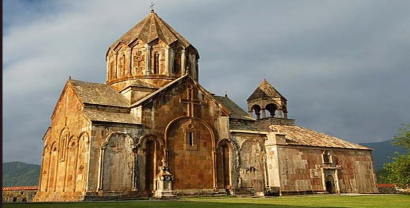Ancient traces of a history from whence we came: Albanian churches

The Azerbaijan State Translation Centre (AzSTC) has produced a documentary archival video footage “Ancient traces of a history from whence we came: Albanian churches” that features the ancient history of the Albans who had lived side-by-side in harmony in Azerbaijani territories with Azerbaijani Turks for centuries, how the Albanian Apostolic Church was transferred to the subordination of the Armenian Gregorian Church on March 11, 1836, under the Decree of the Emperor Nicholas I of Russia.
AzSTC has sent the video footage with subtitles in English, Russian, Turkish, Persian, Arabic, Georgian, French, Ukrainian, Spanish and German languages to accredited foreign embassies and consulates to the Republic of Azerbaijan, as well as distributed among influential global internet and social networks.
Ancient traces of a history from whence we came: Albanian churches
Caucasian Albania, which from time immemorial was given scholarly attention from all over the world with regard to its history, distinctive culture and architectural monuments, is one of the oldest nations that professed Christianity. According to historical sources, Christianity entered Caucasian Albania in the 1st century AD, when religious missionary groups arrived in this region from Jerusalem and Syria. Then, early Christian communities were formed in Caucasian Albania.
The history of the Albanian Apostolic Church, in contrast to the Armenian Gregorian Church, can be traced back to the Church of Jerusalem and to the Patriarchate of Jerusalem in future periods. These are described in greater detail in “The History of the Country of Albania” by Musa Kałankatuaçi, written on orders from Albanian ruler Javanshir. The work particularly points out that St. Elisha, a disciple of Apostle St. Thaddeus, said during the construction of the Kish church at Sheki: “This is our spiritual center and the place of enlightenment of people of the East.” Elisha, who was the first preaching Christianity in Albania, was killed by unknown people and buried in a Sheki suburb. Another clear confirmation of the fact that Christianity in Caucasian Albania had existed long before the appearance of the Armenian Gregorian Church is evidenced by the letter of Catholicos Abraham to the Albanians: “The throne of the Albanian Patriarchate, which existed before our (i.e. Armenian) Patriarchate, was once our adherent.”
According to research, in the 5th - 7th centuries, there were 12 episcopacies across Caucasian Albania: Kabalaka (Gabala), Gashua, Euta, Amaras, Tsri, Balasakan (Sheki), Girdiman, Mets-Kogmank, Mets-Irank, Khaband, Partav (Barda), and Genjeser (Kalbajar). After the seat of the Catholicoses of the Albanian church was transferred to Barda in 552, the church of Barda became a large monastery.
Attempts to armenianize the Albanian churches are also found in the scientific research by many world-renowned historians.
http://www.anl.az/down/meqale/xalqqazeti/xalqqazeti_iyun2009/83866.htm
In 1836, under the decree of Nicolas I, the Caucasian Albanian Metropolitan Bishop was transferred to the subordination of the Armenian Gregorian Church. Thus, the Albanian Apostolic Church was abolished.
Evidence of attempts to armenize Albanian churches can be found in the scientific research by many famous historians. According to Professor Ilya Pavlovich Petrushevsky (1898-1977), a prominent Russian historian, the Armenians throughout history purposefully and consistently tried to armenize the Albanian lands and did not abandon their attempts to pass off the Albanian church for themselves. Petrushevsky in his research emphasized that the historical monuments in Qarabagh had never belonged to the Armenian culture.
https://az.wikipedia.org/wiki/Alban_Həvari_kilsəsi
Nicholas Adontz (1871-1942), in his study, found that the Armenian population had never been important enough in the mountainous part of Qarabagh.
Academician Ziya Bunyadov, an outstanding orientalist, studying the works of the Arab historian of the 7th century Al-Waki, discovers a very remarkable historical fact. Before the invasion of Caucasian Albania, Muʿāwiyah I, early Islamic leader and founder of the great Umayyad dynasty of caliphs (661-680), instructed al- Jurhumia to study the composition of the local population, and to collect intelligence information. The Turks were reported to have predominated in these territories and Turkic was the language of inter-tribal communication.
https://az.wikipedia.org/wiki/
According to many historical sources, the throne of the Albanian Catholicos was located in the monastery of Chola (Derbent) in the 4th- 5th centuries; in the monastery of Barda in the 6th-7th centuries; in the monastery of St. Elysee (Agdere) in the 8th-9th centuries; in the monastery of Khudaveng (Kalbajar) in the 10th-15th centuries; and in the monastery of Genjeser in the 15th-19th centuries.
Archaeological, ethnographic, anthropological sciences assign an important role to coexistence with the Albanians in the formation and ethnogenesis of the Azerbaijani people. Thus, one of the main characters of the famous Azerbaijani epic 'Kitabi Dede Gorgud' Salur Hasan was described as the leader of the Albanians, that the ancient origin of the legend itself demonstrates the eternity of the Azerbaijani-Albanian ties.
According to the historical annals, the ancestors of the Azerbaijani people in ancient times professed Christianity and visited places of worship, such as temples, churches and monasteries that have survived to this day in the historical Albanian-Azerbaijani lands settled by Oghuz Turks.
Albanian Christian churches - Kish (Sheki), Khudaveng, Genjeser (Kalbajar), Gurmuk, Lakit, Gum (Gakh), Avei (Gazakh), Jotare (Gabala), which existed in Azerbaijan for thousands of years, are still revered by our people and protected by the Azerbaijan state .
AND OTHER...
-
 Khagani Shirvani’s Creativity on the Literary Portal of England
Khagani Shirvani’s Creativity on the Literary Portal of England
“Write Out Loud”, the leading poetry portal of England, has posted in English the ghazal “A Love Song” by the great Azerbaijani poet Khagani Shirvani as part of the...
-
 Isi Malikzade’s Creativity on German Literature Magazine
Isi Malikzade’s Creativity on German Literature Magazine
LESERING.de, a popular German e-literature magazine, has posted in German the short story Salt by Isi Malikzade, the notable Azerbaijani writer, as part of the AzSTC project “Azerbaijan Literature in an International Virtual World”.
-
 Movlud Movlud’s Short Story on Turkish Portals
Movlud Movlud’s Short Story on Turkish Portals
“Detayhaberler.com”, “Dibace.net” and “Haber.232.com”, leading Turkish portals, have posted in Turkish the short story “We Have Already Grown Up” by the...









